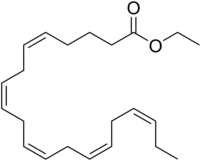
Photo from wikipedia
REDUCE-IT (Reduction of Cardiovascular Events with Icosapent Ethyl-Intervention Trial) randomized 8,179 statin-treated patients with elevated triglycerides and increased cardiovascular (CV) risk to either icosapent ethyl (IPE), a pure, stable prescription… Click to show full abstract
REDUCE-IT (Reduction of Cardiovascular Events with Icosapent Ethyl-Intervention Trial) randomized 8,179 statin-treated patients with elevated triglycerides and increased cardiovascular (CV) risk to either icosapent ethyl (IPE), a pure, stable prescription form of eicosapentaenoic acid, 4g/day or placebo. IPE significantly reduced time to first occurrence of the primary composite endpoint of major adverse CV events (CV death, nonfatal myocardial infarction [MI], nonfatal stroke, coronary revascularization, or hospitalization for unstable angina) (HR 0.75, CI 0.68–0.83) and key secondary endpoint events (composite of CV death, nonfatal MI, or nonfatal stroke) (HR 0.74, CI 0.65–0.83) versus placebo (all p<0.0001). A modest reduction in placebo-corrected LDL-C was observed (−6.6%; p<0.0001). The mechanisms for the CV benefit of icosapent ethyl are not fully understood. Explore the impact of statin type and lipophilic/lipophobic category on outcomes, and on LDL-C, to further consider the possible relevance of LDL-C pathways to the observed CV benefit of icosapent ethyl. Primary and key secondary endpoint analyses and LDL-C changes from baseline were explored by individual statin type (atorvastatin, simvastatin, rosuvastatin, or pravastatin) at baseline, and then by categorizing these statins into lipophilic (i.e., hydrophobic: atorvastatin, simvastatin) and lipophobic (i.e., hydrophilic: rosuvastatin, pravastatin) statin groups; 96.1% of patients fell within these individual statin groups. CV outcomes were similar across statin types (interaction p=0.61) and lipophilic/lipophobic categories (interaction p=0.51) (Figure). Statin type and category had a similar lack of meaningful impact on the modest placebo-corrected median LDL-C changes from baseline to one year, which ranged from −5.8 to −8.4% (all p≤0.0003). No meaningful treatment differences in the primary or key secondary endpoints across statin type or lipophilic/lipophobic category were observed. A similar lack of treatment difference was observed in LDL-C changes from baseline to one year. Therefore, the LDL-C changes and CV risk reduction in REDUCE-IT appear independent of the type of concomitant statin therapy. These data provide clinicians with additional insight regarding concomitant statin therapy considerations when prescribing icosapent ethyl and suggest there are important mechanisms of action for the substantial CV risk reduction observed with icosapent ethyl that are distinct from the LDL receptor pathway. Type of funding source: Other. Main funding source(s): The study was funded by Amarin Pharma, Inc.
Journal Title: European Heart Journal
Year Published: 2020
Link to full text (if available)
Share on Social Media: Sign Up to like & get
recommendations!